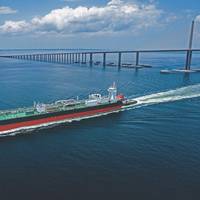Diesel Consumption to Fall with US Manufacturing Downturn

U.S. manufacturers reported business activity declined for the second month running in December and the sector appears to be on the leading edge of a recession. The slowdown in manufacturing and freight has already dampened consumption of diesel and other distillate fuel oils, and consumption is likely to fall if the manufacturing downturn deepens.The Institute for Supply Management’s manufacturing activity index fell to 48.4 in December (19th percentile for all months since 1980)…
Maritime Rule Change Stirs Fears of Diesel Shortage: Kemp

The International Maritime Organization (IMO) has so far resisted pressure to soften or postpone the implementation of new regulations requiring ships to use bunker fuels with a lower sulphur content from the start of 2020.That has prompted warnings from some analysts that the regulations will squeeze the availability of low-sulphur diesel and jet kerosene required by trucks, trains, aircraft, farmers and industry, resulting in big price increases.The regulations and any associated rise in fuel prices will occur in the run up to the next U.S.
Global Trade Surge Fuel Oil Markets
Global trade is growing at the fastest rate for six years - which is both a symptom and a cause of the recovery in commodity markets. World trade volumes were up almost 5 percent year-on-year from May to July, according to estimates compiled by government economic planners in the Netherlands. Growth was four times faster than at the same point in 2016 (http://tmsnrt.rs/2y89NxC). Global trade and commodity markets are linked in a circular causal relationship, which is one of the most important in the macroeconomy and a key source of fluctuations in the business cycle. Commodities, from grains to minerals, metals and oil, are the largest item in global trade by tonnage, so the state of commodity markets has a major impact on world trade flows.
The Evolving ATB Jones Act Business Model

Today’s ATB play seemingly has legs for the long haul, as operators build and market needs fluctuate. The refined product trades are always in flux. Similarly, the supply patterns for products (and for chemicals derived from oil refining) are subject to constant change. At the same time, the distribution of refined petroleum products sees great benefit from the efficiency of Articulated Tug Barges (ATBs), which have the flexibility to adjust to dynamic supply programs between refineries and myriad distribution facilities dotting the coastline. It wasn’t always like that.
U.S. Freight Recovery Spurs Diesel Demand
U.S. freight movements have started increasing again, which should help boost consumption of distillate fuel oil in 2017 and 2018. The tonnage of freight moved by road, rail, barge, pipeline and air cargo has been increasing year on year since October, after stagnating for much of 2015/16 (http://tmsnrt.rs/2qSDLAJ). Freight movements hit a new record in February, before slipping slightly in March, according to the U.S. Bureau of Transportation Statistics (http://tmsnrt.rs/2rTVx58). Most freight is hauled by equipment that uses diesel engines, or jet turbines in the case of air cargo. Freight is therefore the main driver for consumption of fuels refined from the middle of the crude oil barrel, including distillate fuel oil and jet fuel. The U.S.
US O&G Industry Reaps the Benefits of International Trade

Rising exports have thrown a lifeline to U.S. shale producers and refiners, giving them an additional outlet at a time when the domestic market has been at risk of becoming saturated. The United States exported record quantities of natural gas, propane, gasoline, distillate fuel oil and light crude last year while continuing to import the heavy oils needed by its refineries. Gas exports increased by almost 30 percent in 2016 and have more than tripled in the last decade, limiting the build up of unused gas and supporting prices in recent months despite the warmest winter on record.
U.S. Petro Exports Continue to Grow
Total U.S. petroleum product exports continued to increase in 2015, up 467,000 barrels per day (b/d) from 2014 to 4.3 million b/d, driven by increased exports of distillate fuel, motor gasoline, and propane, according to data from the U.S. Energy Information Administration (EIA). Mexico and the region encompassing both Central and South America continued to be major recipients of U.S. petroleum product exports, as exports to the latter region increased in 2015 because of supply constraints that are likely to ease. Exports of distillate fuel oil represent the largest component of U.S. petroleum product exports, and averaged 1.19 million b/d in 2015, an increase of 85,000 b/d from 2014. The United States exported distillate fuel to 88 different countries in 2015. The top destination for U.S.
Preventing Loss of Propulsion After Fuel Switch to Low Sulfur Distillate Fuel

The International Convention for the Prevention of Pollution from Ships (MARPOL) ANNEX VI Regulation 14 requires ships with Marine Compression-Ignition Engines at or Above 30 Liters per Cylinder use fuel with sulfur content less than 0.1%, after 01 January 2015 within the Baltic Sea area – as defined in Annex I of MARPOL, North Sea area – as defined in Annex V of MARPOL; within 200 miles of the North American area and when operating in the United States Caribbean Sea area – as defined in Appendix VII of Annex VI of MARPOL.
A History of U.S. Oil Export Controls

On Oct. 20, 1973, King Faisal of Saudi Arabia imposed a total embargo on oil shipments to the United States among other countries in response to their support for Israel during the Arab-Israeli war. Faisal's decision led directly to the introduction of a ban on U.S. crude exports, which remains in force in a slightly modified form and is now the focus of an intense struggle for reform. Following the U.S. mid-term elections next month, Congress will take up the issue again, a debate that would benefit from an understanding of the history behind the ban. On Oct.
LNG Marine Fuel Taking Hold in America: FMC Commissioner Speaks
In his speech at the LNG Export & Export & Infrastructure Conference Federal Maritime Commissioner Doyle gives insights on the consequences of the adoption of Liquefied Natural Gas (LNG) as a marine fuel in the United States. I am a Commissioner with the U.S. Federal Maritime Commission. The Federal Maritime Commission is an independent regulatory agency responsible for regulating the nation’s international ocean transportation for the benefit of exporters, importers, and the American consumer. I should emphasize that my thoughts and comments here are mine and mine alone – they do not reflect the position of the Commission, and they should not be construed to represent the positions of any of my fellow Commissioners.
Breaking Down The Cost of MARPOL
Since January 8, 2009, United States (U.S.) and foreign flagged ships operating in the waters of the U.S. have been subject to MARPOL Annex VI. The Marine Environmental Protection Committee (MEPC) of the International Maritime Organization (IMO) adopted amendments to Annex VI and the nitrogen oxides (NOx) Technical Code, collectively referred to as Annex VI (Revised). Annex VI (Revised) entered into force on July 1, 2010. These amendments include significant and progressive limits for sulfur oxide (SOx) and NOx emissions from marine engines and for the first time addressed emissions of Particulate Matter (PM). The amendments replaced the SOx Emissions Control Areas (SECA) by introducing the concept of Emission Control Areas (ECA) for SOx, NOx, and PM.
EIA: Short-Term Energy Outlook

Average crude oil prices for July were little changed from June. The West Texas Intermediate (WTI) spot average for July was $30.75 per barrel compared to $30.66 in June. EIA’s Outlook is for prices to remain firm through the rest of 2003, or at least until autumn, when OECD oil inventories may rebuild above observed 5-year lows. Once inventories have been rebuilt, WTI oil prices may slide gradually to $26 per barrel during 2004, as Iraqi oil exports return to near pre-war levels. U.S.





